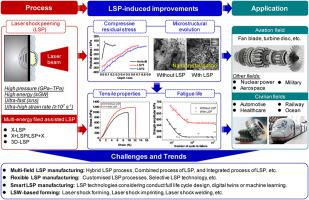International Journal of Machine Tools and Manufacture ( IF 14.0 ) Pub Date : 2023-08-04 , DOI: 10.1016/j.ijmachtools.2023.104061 Weiwei Deng , Changyu Wang , Haifei Lu , Xiankai Meng , Zhao Wang , Jiming Lv , Kaiyu Luo , Jinzhong Lu

|
Grain refinement and arrangement is an effective strategy to enhance tensile and fatigue properties of key metallic components. Laser shock peening (LSP) is one of surface severe plastic deformation methods in extreme conditions, with four distinctive features, namely, high pressure (1 GPa–1 TPa), high energy (more than 1 GW), ultra-fast (no more than nanosecond scale), and ultra-high strain rate (more than 106 s−1), and generates a deeper compressive residual stress (CRS) field and the formation of a gradient nanostructure in the surface layer to prevent the crack initiation of metallic materials and alloys, which is widely used in aerospace, overload vehicle, ocean engineering, and nuclear power. Despite some investigations of LSP on surface integrity, microstructural evolution, and mechanical properties of metallic materials and alloys, there is a lack of a comprehensive perspective of LSP-induced microstructural evolution, mechanical properties for metallic materials and alloys in the last two decades. Furthermore, the relationship between the mechanical properties of metallic materials and alloys and the LSP processing parameters is presented. In particular, LSP-induced featured microstructure and grain refinement mechanisms in three kinds of crystal structures, for instance, face-centred cubic, body-centred cubic, and hexagonal close-packed metals, are present and summarised for the first time. In addition, some new emerging hybrid LSP technologies and typical industrial applications as important chapters are shown. Finally, the faced challenges and future trends in the next 10–20 years are listed and discussed. Results to date indicate that LSP, as an emerging and novel surface modification technology, has been increasingly used to surface layer of metallic components. These topics discussed could provide some important insights on researchers and engineers in the fields of surface modification and advanced laser manufacturing.
中文翻译:

金属材料和合金激光冲击强化的进展、挑战和未来趋势:全面综述
晶粒细化和排列是提高关键金属部件拉伸和疲劳性能的有效策略。激光冲击强化(LSP)是极端条件下的表面剧烈塑性变形方法之一,具有高压(1 GPa-1 TPa)、高能量(大于1 GW)、超快(不超过1 GW)四大显着特点。纳秒级)和超高应变率(超过10 6 s -1),并产生更深的压缩残余应力(CRS)场并在表层形成梯度纳米结构,以防止金属材料和合金的裂纹萌生,广泛应用于航空航天、超载车辆、海洋工程、核能等领域力量。尽管对LSP对金属材料和合金的表面完整性、微观结构演化和力学性能进行了一些研究,但在过去的二十年中,缺乏对LSP引起的金属材料和合金的微观结构演化、力学性能的全面视角。此外,还提出了金属材料和合金的机械性能与 LSP 加工参数之间的关系。尤其,首次提出并总结了面心立方、体心立方和六方密排金属等三种晶体结构中LSP诱导的特征微观结构和晶粒细化机制。此外,还介绍了一些新兴的混合LSP技术和典型的行业应用作为重要章节。最后,列出并讨论了未来10-20年面临的挑战和未来趋势。迄今为止的结果表明,LSP作为一种新兴的新型表面改性技术,已越来越多地应用于金属部件的表面层。讨论的这些主题可以为表面改性和先进激光制造领域的研究人员和工程师提供一些重要的见解。和六方密排金属,首次出现并总结。此外,还介绍了一些新兴的混合LSP技术和典型的行业应用作为重要章节。最后,列出并讨论了未来10-20年面临的挑战和未来趋势。迄今为止的结果表明,LSP作为一种新兴的新型表面改性技术,已越来越多地应用于金属部件的表面层。讨论的这些主题可以为表面改性和先进激光制造领域的研究人员和工程师提供一些重要的见解。和六方密排金属,首次出现并总结。此外,还介绍了一些新兴的混合LSP技术和典型的行业应用作为重要章节。最后,列出并讨论了未来10-20年面临的挑战和未来趋势。迄今为止的结果表明,LSP作为一种新兴的新型表面改性技术,已越来越多地应用于金属部件的表面层。讨论的这些主题可以为表面改性和先进激光制造领域的研究人员和工程师提供一些重要的见解。列出并讨论了未来 10-20 年面临的挑战和未来趋势。迄今为止的结果表明,LSP作为一种新兴的新型表面改性技术,已越来越多地应用于金属部件的表面层。讨论的这些主题可以为表面改性和先进激光制造领域的研究人员和工程师提供一些重要的见解。列出并讨论了未来 10-20 年面临的挑战和未来趋势。迄今为止的结果表明,LSP作为一种新兴的新型表面改性技术,已越来越多地应用于金属部件的表面层。讨论的这些主题可以为表面改性和先进激光制造领域的研究人员和工程师提供一些重要的见解。



























 京公网安备 11010802027423号
京公网安备 11010802027423号